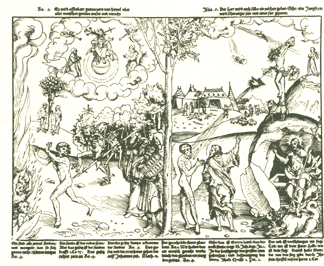


R. W. Scribner, For the Sake of Simple Folk: Popular Propaganda for the German Reformation, Cambridge University Press, 1981, pp 216-217:
"The most effective and successful of the doctrinal representations came from the school of Lucas Cranach, the contrast between the Law and the Gospel, or the Old and New Testaments. The earliest example from Lucas Cranach the Elder comes from the later 1520s. It is based on the antithesis, a form used so often throughout Reformation propaganda. The visual space is divided down the centre by a tree, to the left of which is depicted the Law as expounded in the Old Testament. In the left background, Adam and Eve east the fruit of the tree of life aftern being tempted by the serpent. As a result of this original sin, man is the prey of death and the Devil, through he can only be damned, indicated by the two figures hounding Man into the jaws of hell. This is Man under the Law, signified by Moses holding the tables of the Ten Commandments, with other Old Testament prophets behind him. In the clouds above, Christ as Lord of the world sits judging man, with the sword and the lily in his ears. Two figures, Mary and John the Baptist, seek to interced for sinful man, although in vain. The gloomy message of the Old Testament and the Law, which only condemn man, is also signified in the barren branches on the Old Testament side of the antithesis formed by the central tree.
In opposition to the hardness of the Law, the Gospel brings hope, signified by the blooming branches on the New Testament side of the tree. In the background is depicted, however, an Old Testament scene, the brazen serpent, the figure of Christ's saving death on the cross. On the hill in the right background Mary receives the rays of heavenly grace, signifying the incarnation, further indicated by the angel bearing the cross down to her. To the left, further indicated by the angel brings the news of the birth of the Saviour to the shepherds on the hills of Bethlehem. The main figures on this side depict the events through which the Gospel message is realised. The crucified Christ sheds his saving blood in a stream onto man. Through the agency of the Holy Spirit, the dove through which the stream passes, this becomes the saving water of baptism. Man has his attention called to the sacrificial death of Christ by the figure of John the Baptist. Beneath the crucifix is the paschal lamb, the symbol of Christ's victorious death, which is completed by his resurrrection. This is depicted in the bottom right-hand corner, where Christ overcomes death and the apocalyptic beast, representing the Devil. This completes man's release from sin and death, neatly balancing the corresponding depiction on the far left.
This schema became one of the most popular themes of the Reformation, largely because it captured so effectively the gist of Luther's doctrine. Indeed, it seems to have been most directlty inspired by some of Luther's expositions on the theme of the Law and the Gospel, such as that in his commentary on Galatians. It was a wholly biblical depiction and relied on signs accessible to every person of the time. Above all, it established a uniquely evangelical position, without reference to papal or Catholic teaching. It could be used purely as a visual representation, or supplied with appropriate biblical references.... The Law is headed by a citation from Romans 1.18: "The wrath of God is revealed from heaven against all ungodliness and wickedness of men." The Gospel is headed by a verse of Isaiah 7.14, which shows the prophetic link between the Old and New Testaments: "The Lord himself will give you a sign. Behold, a young woman shall conceive and bear a son." Beneath the depiction of hte Law are quotations spelling out its significance ( Romans 3.23; 1 Corinthians 15.56; Romans4.15; Romans 3.20 and Matthew 11.13). The Gospel is likewise supplied with texts on faith (Romans 1.17 and 3.21 --both classic expressions of the basic Lutheran doctrine that the just live through faith), and expressing the hope of salvation (John 1.29; 1 Peter 1.2 and 1 Corinthians 15.55). The combination of scriptural texts and visual signs expressing their content made such a depiction the evangelical version of the Pauper's Bible.
